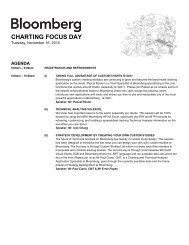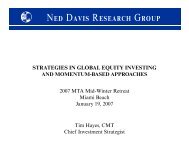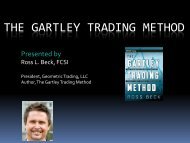Journal of Technical Analysis - Market Technicians Association
Journal of Technical Analysis - Market Technicians Association
Journal of Technical Analysis - Market Technicians Association
Create successful ePaper yourself
Turn your PDF publications into a flip-book with our unique Google optimized e-Paper software.
26<br />
Inferring Trading Strategies From Probability Distribution Functions<br />
John Ehlers<br />
Background<br />
Jo u r n a l <strong>of</strong> <strong>Technical</strong> <strong>Analysis</strong> • 2008 • Issue 65<br />
3<br />
The primary purpose <strong>of</strong> technical analysis is to observe market events and tally their consequences to formulate predictions. In this sense market technicians are<br />
dealing with statistical probabilities. In particular, technicians <strong>of</strong>ten use a type <strong>of</strong> indicator known as an oscillator to forecast short-term price movements.<br />
An oscillator can be viewed as a high pass filter in that it removes lower frequency trends while allowing the higher frequencies components, i.e., short-term<br />
price swings to remain. On the other hand, moving averages act as a low pass filters by removing short-term price movements while permitting longer-term trend<br />
components to be retained. Thus moving averages function as trend detectors whereas oscillators act in an opposite manner to “de-trend” data in order to enhance<br />
short term price movements. Oscillators and moving averages are filters that convert price inputs into output waveforms to magnify or emphasize certain aspects <strong>of</strong><br />
the input data. The process <strong>of</strong> filtering necessarily removes information from the input data and its application is not without consequences.<br />
A significant issue with oscillators (as well as moving averages) for short term trading is that they introduce lag. While academically interesting, the consequences<br />
<strong>of</strong> lag are costly to the trader. Lag stems from the fact that oscillators by design are reactive rather than anticipatory. As a result, traders must wait for confirmation;<br />
a process that introduces additional lag into the ability to take action. It is now widely accepted that classical oscillators can be very accurate in hindsight but are<br />
typically inadequate for forecasting future short-term market direction, in large part due to lag.<br />
Probability Distribution Functions<br />
The basic shortcoming <strong>of</strong> classical oscillators is that they are reactive rather than anticipatory. As a result, the undesirable lag component in oscillators significantly<br />
degrades their usefulness as a tool for pr<strong>of</strong>itable short-term trading. What is needed is an effective mechanism for anticipating turning points.<br />
The Probability Distribution Function (PDF) can be borrowed from the field <strong>of</strong> statistics and used to examine detrended market prices for the purpose <strong>of</strong> inferring<br />
trading strategies. The PDF <strong>of</strong>fers an alternative approach to the classical oscillator; one that is non-causal in anticipating short-term turning points.<br />
PDFs place events into “bins” with each bin containing the number <strong>of</strong> occurrences in the y-axis and the range <strong>of</strong> events in the x-axis. For example, consider the<br />
square wave shown in Figure 1A. Although unrealistic in the real world, if one were to envision the square wave as “quantum” prices that can only have values <strong>of</strong><br />
-1 or +1, the resultant PDF consists simply <strong>of</strong> two vertical “spikes” at -1 and +1 as shown in Figure 1B. Such a waveform could not be traded using conventional<br />
oscillators because any price movement would be over before the oscillator could yield a signal. However as the PDFs below will show, the theoretical square wave<br />
is not far removed from real-world short term cycles.<br />
As a practical example, a theoretical sine wave can be used to more accurately model real-world detrended prices. An idealized sinewave is shown in Figure 1C<br />
and its corresponding PDF in Figure 1D. The PDFs <strong>of</strong> the square wave and that <strong>of</strong> the sine wave are remarkably similar. In each case there is a high probability <strong>of</strong><br />
the waveforms being near their extremes as can be seen in the large spikes in Figure 1D. These spikes correspond to short-term turning points in the detrended prices.<br />
The probability is high near the turning points because there is very little price movement in these phases <strong>of</strong> the cycle, with prices ranging only from about 0.8 to 1.0<br />
and -0.8 to -1.0 in Figure 1C.

















